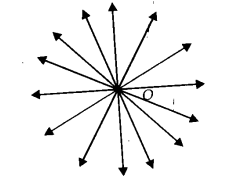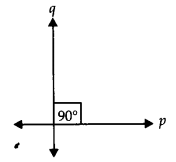NCERT Solutions for Class 9 Maths Chapter 5 - Introduction to Euclid's Geometry
These solutions cover all important questions and exercises that are needed to understand this chapter, such as definitions, theorems, and reasoning logically. Each solution is written in a very clear and understandable manner by students.
Access Answers to NCERT Solutions for Class 9 Maths Chapter 5 - Introduction to Euclid's Geometry
Students can access the NCERT Solutions for Class 9 Maths Chapter 5 - Introduction to Euclid's Geometry. Curated by experts according to the CBSE syllabus for 2023–2024, these step-by-step solutions make Maths much easier to understand and learn for the students. These solutions can be used in practice by students to attain skills in solving problems, reinforce important learning objectives, and be well-prepared for tests.
Exercise 5.1
Which of the following statements are true and which are false? Give reasons for your answers.
(i) Only one line can pass through a single point.
(ii) There are an infinite number of lines which pass through two distinct points.
(iii) A terminated line can be produced indefinitely on both the sides.
(iv) If two circles are equal, then their radii are equal.
(v) In figure, if AB – PQ and PQ = XY, then AB = XY.
.png)
(i) False
Reason : If we mark a point O on the surface of a paper. Using pencil and scale, we can draw infinite number of straight lines passing
through O.


(ii) False
Reason : In the following figure, there are many straight lines passing through P. There are many lines, passing through Q. But there is one and only one line which is passing through P as well as Q.
(iii) True
Reason: The postulate 2 says that “A terminated line can be produced indefinitely.”
(iv) True
Reason : Superimposing the region of one circle on the other, we find them coinciding. So, their centres and boundaries coincide.
Thus, their radii will coincide or equal.
(v) True
Reason : According to Euclid’s axiom, things which are equal to the same thing are equal to one another.
Give a definition for each of the following terms. Are there other terms that need to be defined first? What are they and how might you define them?
(i) Parallel lines
(ii) Perpendicular lines
(iii) Line segment
(iv) Radius of a circle
(v) Square
Yes, we need to have an idea about the terms like point, line, ray, angle, plane, circle and quadrilateral, etc. before defining the required terms.
Definitions of the required t erms are given below :
(i) Parallel Lines :
Two lines l and m in a plane are said to be parallel, if they have no common point and we write them as l ॥ m.

(ii) Perpendicular Lines :
Two lines p and q lying in the same plane are said to be perpendicular if they form a right angle and we write them as p ⊥ q.

(iii) Line Segment :
A line segment is a part of line and having a definite length. It has two end-points. In the figure, a line segment is shown having end points A and B. It is written as
 or
or 

(iv) Radius of a circle :
The distance from the centre to a point on the circle is called the radius of the circle. In the figure, P is centre and Q is a point on the circle, then PQ is the radius.

(v) Square :
A quadrilateral in which all the four angles are right angles and all the four sides are equal is called a square. Given figure, PQRS is a square.

Consider two ‘postulates’ given below
(i) Given any two distinct points A and B, there exists a third point C which is in between A and B.
(ii) There exist atleast three points that are not on the same line.
Do these postulates contain any undefined terms? Are these postulates consistent? Do they follow from Euclid’s postulates? Explain.
Yes, these postulates contain undefined terms such as ‘Point and Line’. Also, these postulates are consistent because they deal with two different situations as
(i) says that given two points A and B, there is a point C lying on the line in between them. Whereas
(ii) says that, given points A and B, you can take point C not lying on the line through A and B.
No, these postulates do not follow from Euclid’s postulates, however they follow from the axiom, “Given two distinct points, there is a unique line that passes through them.”
If a point C lies between two points A and B such that AC = BC, then prove that AC = 1/2 AB, explain by drawing the figure.
We have,

AC = BC [Given]
∴ AC + AC = BC + AC
[If equals added to equals then wholes are equal]
or 2AC = AB [∵ AC + BC = AB]
or AC = 1/2AB
In question 4, point C is called a mid-point of line segment AB. Prove that every line segment has one and only one mid-point.
Let the given line AB is having two mid points ‘C’ and ‘D’.

AC = 1/2AB……(i)
and AD = 1/2AB……(ii)
Subtracting (i) from (ii), we have
AD – AC = 1/2AB-1/2AB
or AD – AC = 0 or CD = 0
∴ C and D coincide.
Thus, every line segment has one and only one mid-point.
In figure, if AC = BD, then prove that AB = CD.

Given: AC = BD
⇒ AB + BC = BC + CD
Subtracting BC from both sides, we get
AB + BC – BC = BC + CD – BC
[When equals are subtracted from equals, remainders are equal]
⇒ AB = CD
Why is axiom 5, in the list of Euclid’s axioms, considered a ‘universal truth’? (Note that, the question is not about the fifth postulate.)
As statement is true in all the situations. Hence, it is considered a ‘universal truth.’
Exercise 5.2
How would you rewrite Euclid’s fifth postulate so that it would be easier to understand?
We need to rewrite Euclid’s fifth postulate so that it is easier to understand.
We know that Euclid’s fifth postulate states that “No intersection of lines will take place when the sum of the measures of the interior angles on the same side of the falling line is exactly 180°.”
We know that Play fair’s axiom states that “For every line l and for every point P not lying on l, there exists a unique line m passing through P and parallel to l”.
The above mentioned Play fair’s axiom is easier to understand in comparison to the Euclid’s fifth postulate.
Let us consider a line l that passes through a point p and another line m. Let these lines be at a same plane.
Let us consider the perpendicular CD on l and FE on m.

From the above figure, we can conclude that CD = EF.
Therefore, we can conclude that the perpendicular distance between lines m and l will be constant throughout, and the lines m and l will never meet each other or in other words, we can say that the lines m and l are equidistant from each other.
Does Euclid’s fifth postulate imply the existence of parallel lines? Explain.
We need to verify whether Euclid’s fifth postulate imply the existence of parallel lines or not.
The answer to the above statement is Yes.
Let us consider two lines m and l.
In the figure given below, we can conclude that the lines m and l will intersect further.

From the figure, we can conclude that
 and
and 
We know that Euclid’s fifth postulate states that “No intersection of lines will take place when the sum of the measures of the interior angles on the same side of the falling line is exactly 180°.”
Let us consider lines l and m.

From the above figure, we can conclude that lines l and m will never intersect from either side.
Therefore, we can conclude that the lines l and m are parallel.
Frequently Asked Questions
The NCERT solution for Class 9 Chapter 5: Introduction to Euclid’s Geometry is important as it provides a structured approach to learning, ensuring that students develop a strong understanding of foundational concepts early in their academic journey. By mastering these basics, students can build confidence and readiness for tackling more difficult concepts in their further education.
Yes, the NCERT solution for Class 9 Chapter 5: Introduction to Euclid’s Geometry is quite useful for students in preparing for their exams. The solutions are simple, clear, and concise allowing students to understand them better. They can solve the practice questions and exercises that allow them to get exam-ready in no time.
You can get all the NCERT solutions for Class 9 Maths Chapter 5 from the official website of the Orchids International School. These solutions are tailored by subject matter experts and are very easy to understand.
Yes, students must practice all the questions provided in the NCERT solution for Class 9 Maths Chapter 5: Introduction to Euclid’s Geometry as it will help them gain a comprehensive understanding of the concept, identify their weak areas, and strengthen their preparation.
Students can utilize the NCERT solution for Class 9 Maths Chapter 5 effectively by practicing the solutions regularly. Solve the exercises and practice questions given in the solution.

